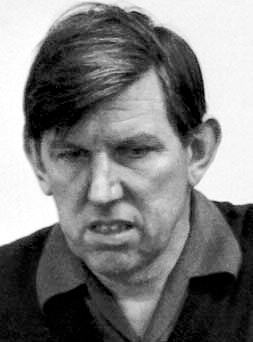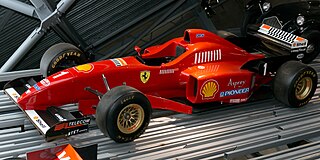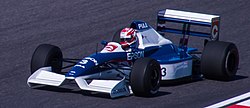The Tyrrell Racing Organisation was an auto racing team and Formula One constructor founded by Ken Tyrrell (1924–2001) which started racing in 1958 and started building its own cars in 1970. The team experienced its greatest success in the early 1970s, when it won three Drivers' Championships and one Constructors' Championship with Jackie Stewart. The team never reached such heights again, although it continued to win races through the 1970s and into the early 1980s, taking the final win for the Ford Cosworth DFV engine at Detroit in 1983. The team was bought by British American Tobacco in 1997 and completed its final season as Tyrrell in 1998. Tyrrell's legacy continues in Formula One as the Mercedes-AMG F1 team, who is Tyrrell's descendant through various sales and rebrandings via BAR, Honda and Brawn GP.

The DFV is an internal combustion engine that was originally produced by Cosworth for Formula One motor racing. The name is an abbreviation of Double Four Valve, the engine being a V8 development of the earlier four-cylinder FVA, which had four valves per cylinder.

Robert Kenneth Tyrrell was a British Formula Two racing driver and the founder of the Tyrrell Formula One constructor.

Harvey Ernest Postlethwaite was a British engineer and Technical Director of several Formula One teams during the 1970s, 1980s and 1990s. He died of a heart attack in Spain while supervising the testing of the aborted Honda F1 project.
David Keith Duckworth was an English mechanical engineer. He is most famous for designing the Cosworth DFV engine, an engine that revolutionised the sport of Formula One.

The Brabham BT46 is a Formula One racing car designed by Gordon Murray for the Brabham team, owned by Bernie Ecclestone, for the 1978 Formula One season. The car featured several radical design elements, one of which was the use of flat panel heat exchangers on the bodywork of the car to replace conventional water and oil radiators. It was removed before the car's race debut, never to be seen again. The cars, however, powered by a flat-12 Alfa Romeo engine, raced competitively with modified nose-mounted radiators for most of the year, driven by Niki Lauda and John Watson, winning one race in this form and scoring sufficient points for the team to finish third in the constructors championship.

The McLaren M23 was a Formula One racing car designed by Gordon Coppuck, with input from John Barnard, and built by the McLaren team. It was a development of the McLaren M16 Indianapolis 500 car. A Ford Cosworth DFV engine was used, which was prepared by specialist tuning company Nicholson-McLaren Engines. This helped push the DFV's horsepower output to around 490 bhp.

The Ferrari 312T was a Ferrari Formula One car design, based on the 312B3 from 1974. In various versions, it was used from 1975 until 1980. It was designed by Mauro Forghieri for the 1975 season, and was an uncomplicated and clean design that responded well to mechanical upgrades.

The Ferrari F310, and its evolution, the F310B, were the Formula One racing cars with which the Ferrari team competed in the 1996 and 1997 seasons. It was driven in both years by Michael Schumacher, who was swapped with Benetton in favour of Jean Alesi and Eddie Irvine.

A suspension keel is an extension pylon to the bodywork of single-seat, open wheel racing cars designed with a raised nose cone, to allow the lower suspension arms to be attached to the car approximately parallel to the road surface. In recent years the placing and design of a suspension keel, or the lack of such, has been one of the few distinct variables in Formula One chassis design.

The Tyrrell 012 is a Formula One racing car that was designed by Maurice Philippe for the Tyrrell team. It was introduced for the 1983 season, and was subsequently used in 1984 and the first few races of 1985.

The Ferrari F92A was a Formula One car designed by Jean-Claude Migeot for Ferrari for use in the 1992 Formula One season. There were two versions of the car, the original version raced in the first eleven races of the season, with the updated F92AT version racing in the latter stages of the season. The car was driven by Jean Alesi for the entire season, and by Ivan Capelli for most of the season, before he was sacked and replaced by Nicola Larini.

The Arrows A2 was a Formula One racing car, designed by Tony Southgate and Dave Wass, was used by the Arrows team in the latter half of the 1979 Formula One season. Powered by a Cosworth DFV V8 engine and driven by Riccardo Patrese and Jochen Mass, it was relatively unsuccessful with its best finish being sixth on two occasions.

The Tyrrell 018 was a Formula One racing car designed by Harvey Postlethwaite and Jean-Claude Migeot. It was built and raced by Tyrrell Racing. It used a customer Ford DFR engine.

The Benetton B190 is a Formula One racing car designed by Rory Byrne in collaboration with Benetton's Technical Director, John Barnard, a designer with experience at racing companies McLaren and Ferrari and arguably the most successful Formula One designer of the 1980s with his cars winning 31 races since 1981. Geoff Goddard, chief designer at Cosworth was responsible for designing the car's engine, which was of exclusive use for Benetton. The B190 was raced by Benetton in all but the first two races of the 1990 Formula One season.
The Tyrrell 017 was a Formula One racing car designed by Maurice Philippe and Brian Lisles. It was built and raced by Tyrrell Racing in the 1988 season and also for the first race of the 1989 season. It used a customer Cosworth DFZ V8 engine as had its predecessor. The car was driven in 1988 by British pair Jonathan Palmer and Formula One rookie Julian Bailey. Bailey was replaced by Michele Alboreto in 1989 as was the Cosworth DFZ replaced by the more powerful 1988 motor the Cosworth DFR.
The Subaru 1235 was a motor racing engine designed and built by Motori Moderni, and funded by Subaru for the Japanese manufacturer’s Formula One program in 1990. A 3.5-litre boxer-12, it was used by the Coloni team for the first eight races, but proved to be very unsuccessful and the team reverted to using the old Cosworth DFR V8 engine. Alba also used it in the World Sportscar Championship in 1990, but were similarly unsuccessful and switched to a 4.5-litre Buick V6 midway through the season.

The HB is a series of 3.5-litre, naturally-aspirated V8 Formula One racing engines, designed, developed and produced by Cosworth, in partnership with Ford; and used between 1989 and 1994. The customer engines were used by Benetton, Fondmetal, McLaren, Lotus, Minardi, Footwork, Simtek, and Larrousse.
The EC and ED family are a series of 3.0-litre and 3.5-litre, naturally-aspirated, V8, Formula One racing engines, designed, developed and produced by Cosworth, in partnership with Ford; and used between 1994 and 1997. The customer engines were used by Benetton, Sauber, Forti, Lola, Simtek, Pacific, Minardi, and Tyrrell.

The Lola T280, and its evolutions, the Lola T282, Lola T284, and Lola T286, are a series of 3-liter Group 5 sports prototype race cars, designed by Eric Broadley, John Barnard, and Patrick Head, and developed and built by British manufacturer and constructor Lola, for World Sportscar Championship sports car racing, between 1972 and 1976.
















